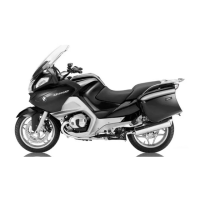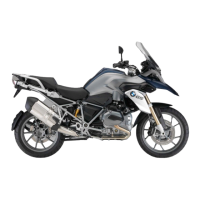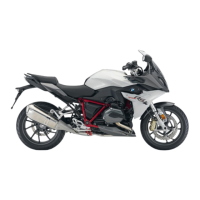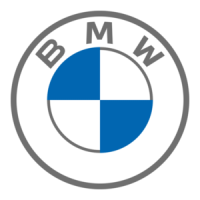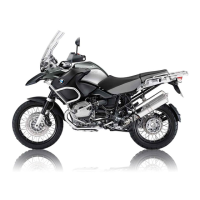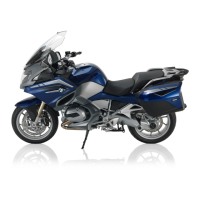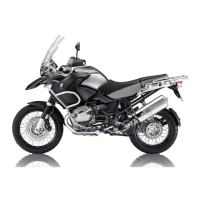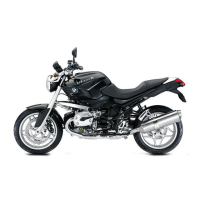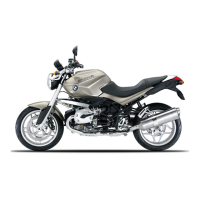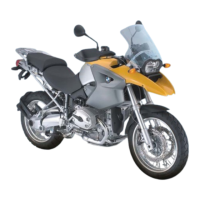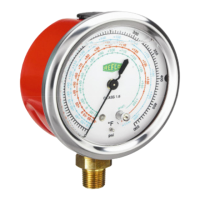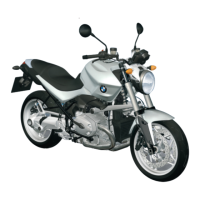
Do you have a question about the BMW R 1200 R 2010 and is the answer not in the manual?
| Displacement | 1170 cc |
|---|---|
| Bore x Stroke | 101 mm x 73 mm |
| Compression Ratio | 12.0:1 |
| Maximum Torque | 119 Nm at 6, 000 rpm |
| Seat Height | 800 mm |
| Wheelbase | 1, 495 mm |
| Fuel Capacity | 18 liters |
| Maximum Power | 81 kW (110 hp) at 7, 500 rpm |
| Transmission | 6-speed |
| Frame | Steel bridge frame |
| Rear Suspension | Paralever |
| Front Brakes | Dual disc, 320 mm |
| Rear Brakes | Single disc, 265 mm |
| ABS | Optional |
| Engine Type | Air/oil-cooled flat twin ('Boxer') 4-stroke engine, two camshafts, four valves per cylinder |
Identifies indicators, speedometer, clock, multifunction display, odometer, and tachometer on the instrument cluster.
Describes how warnings are indicated using warning lights and symbols in the multifunction display.
Details warnings related to the Anti-Lock Brake System (ABS), including self-diagnosis and error indications.
Explains warning indicators for Automatic Stability Control (ASC), covering intervention, deactivation, and errors.
Details warnings related to Tire Pressure Control (TPC/RDC), including critical pressure and transmission errors.
Explanation of the electronic immobilizer system and its operation with keys for starting the motorcycle.
Information on displaying tire inflation pressure, its temperature dependency, and ranges.
Instructions for switching ASC on and off, including self-diagnosis procedures.
Setting spring preload for rear suspension based on load, and adjusting front/rear suspension settings.
Adjusting damping characteristics to suit road conditions and spring preload for optimal handling.
Options for adjusting suspension electronically, combining spring preload and damping settings.
Essential rider safety gear, reduced ground clearance, and correct loading procedures for safe operation.
Procedures for starting the engine with side stand and transmission, including ignition and ABS self-diagnosis.
Safety precautions for refueling, including fuel flammability, expansion, and recommended fuel types.
Explanation of the partially integral brake system and how ABS works to ensure stability.
How ASC works by comparing wheel speeds and adapting engine torque for stability.
Functionality of tire pressure sensors, ranges, and temperature compensation for accurate readings.
Operating safety for brakes, checking operation, and ensuring reliability by having work done by specialists.
Checking front and rear brake pad thickness and wear indicators to ensure optimal braking performance.
Checking front and rear brake fluid levels, emphasizing the importance of maintaining the correct level.
Checking clutch operation and fluid level, ensuring proper engagement and fluid levels.
Checking tire tread depth and wear indicators, and recommendations for tire replacement.
Procedures for jump-starting the engine, with warnings about using the onboard socket and correct connections.
Maintenance instructions for the battery, including charging, storage, and troubleshooting.
Lists common engine starting problems, their possible causes, and remedies.
Specifications for torque values for various threaded fasteners on the front and rear wheels.
Detailed technical specifications for the engine, including design, displacement, output, and torque.
Specifications for engine oil capacity, recommended types, and viscosity classes based on temperature.
Technical details of the brake system, including type, material, and recommended tire combinations.
Front and rear wheel design, rim size, tire designation, and inflation pressures.
